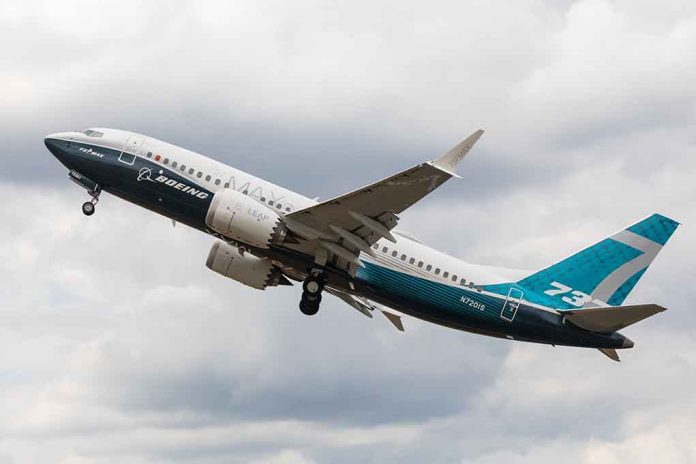
Boeing’s quality control crisis led to a dangerous mid-air door blowout that could have resulted in catastrophic casualties, yet the aviation giant’s “systemic failures” went unchecked despite multiple warning signs.
Key Takeaways
- Four critical bolts securing the door plug panel were removed and never replaced during assembly of the Boeing 737 Max involved in the Alaska Airlines incident
- The NTSB report identified failures across Boeing, supplier Spirit AeroSystems, and the FAA’s oversight procedures that created a “long chain of events” leading to the dangerous incident
- Boeing workers reported feeling pressured and unqualified for certain tasks, highlighting serious workplace culture issues
- The FAA has capped Boeing’s 737 Max production at 38 jets per month until comprehensive safety improvements are implemented
- A redesigned door plug with backup systems is under development but won’t be certified until 2026
Safety Failures Culminate in Terrifying Mid-Air Incident
The National Transportation Safety Board’s (NTSB) comprehensive report on the Alaska Airlines flight 1282 incident has revealed a disturbing pattern of negligence and oversight failures at Boeing, its supplier Spirit AeroSystems, and federal regulators. The January 2024 incident, which saw a door plug panel blow out shortly after takeoff from Portland, Oregon, created a violent decompression that resulted in eight injuries. The failure could have been much worse had the aircraft reached cruising altitude or if passengers had been seated near the compromised section when it failed.
NTSB investigators determined that four bolts meant to secure the door plug panel were removed during manufacturing and never reinstalled, representing a catastrophic quality control failure. The investigation revealed that Boeing’s documentation was inadequate, employee training was insufficient, and workers often felt unprepared for tasks they were assigned. More alarming is that internal warnings about these issues had been repeatedly raised but ignored by management.
Culture of Negligence Exposed
The investigation revealed a troubling culture at Boeing where production pressures routinely trumped safety concerns. Workers reported feeling rushed and unqualified for critical assembly tasks, with many raising concerns through internal reporting systems that went unaddressed. The NTSB found that multiple quality alerts, employee reports, and regulatory compliance issues had highlighted problems across Boeing’s production lines, yet these warnings failed to trigger appropriate corrective actions.
“The truth is, there was a long chain of events that led to the door plug departure. Problems were identified in numerous Boeing internal audits across production lines, employee speak-up reports, quality alerts, and regulatory compliance issues,” said Jennifer Homendy, NTSB Chairwoman, at a June 24 hearing.
The report also highlighted serious deficiencies in the FAA’s oversight mechanisms, which failed to identify and correct the systemic issues at Boeing despite having inspectors embedded in the company’s facilities. This represents a breakdown of the regulatory framework designed to protect the flying public from exactly these types of preventable incidents.
Regulatory Response and Path Forward
In response to the NTSB findings, the FAA has implemented more stringent oversight of Boeing’s manufacturing processes and capped production of the troubled 737 Max at just 38 aircraft per month. This limitation will remain in place until Boeing demonstrates substantial improvements in quality control procedures. The aviation regulator claims it has fundamentally changed its approach to Boeing supervision since the incident.
“has fundamentally changed how it oversees Boeing since the Alaska Airlines door-plug accident and we will continue this aggressive oversight to ensure Boeing fixes its systemic production-quality issues. We are actively monitoring Boeing’s performance and meet weekly with the company to review its progress and any challenges it’s facing in implementing necessary changes,” stated FAA.
Boeing and Spirit AeroSystems are now working on a redesigned door plug that includes a backup retention system, though this improved design isn’t expected to be certified until 2026. The NTSB has recommended that this improved system be retrofitted to all existing 737 Max aircraft. Boeing has also hired a new CEO and created a senior vice president of quality position specifically tasked with enhancing manufacturing practices across the company.
“We at Boeing regret this accident and continue to work on strengthening safety and quality across our operations,” said Boeing, in a statement.
Broader Implications for Aviation Safety
This incident represents the latest in a series of safety failures for Boeing’s 737 Max program, which was previously grounded worldwide following two fatal crashes in 2018 and 2019 that killed 346 people. The continuing problems suggest that despite public assurances, the company has struggled to implement the cultural and procedural reforms necessary to ensure passenger safety. The NTSB report serves as a stark reminder that aviation safety depends not just on technology, but on rigorous adherence to processes, proper documentation, adequate training, and a culture that prioritizes safety over production goals.
For conservative Americans already concerned about regulatory capture and corporate accountability, this incident highlights how government agencies like the FAA can become too cozy with the industries they oversee, potentially putting profit ahead of public safety. The findings underscore the need for robust oversight of critical industries, particularly when public safety is at stake, and the importance of holding both corporations and regulatory bodies accountable when they fail to meet their obligations to the American people.





